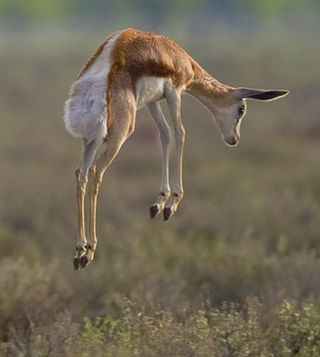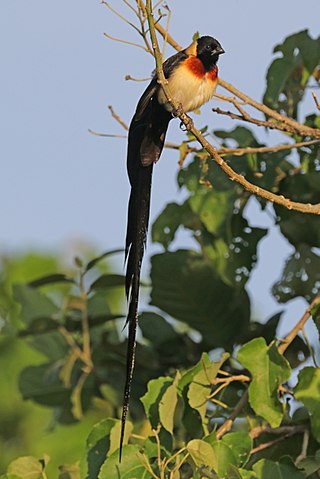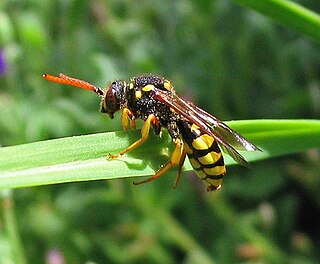Related Research Articles
A pheromone is a secreted or excreted chemical factor that triggers a social response in members of the same species. Pheromones are chemicals capable of acting like hormones outside the body of the secreting individual, to affect the behavior of the receiving individuals. There are alarm pheromones, food trail pheromones, sex pheromones, and many others that affect behavior or physiology. Pheromones are used by many organisms, from basic unicellular prokaryotes to complex multicellular eukaryotes. Their use among insects has been particularly well documented. In addition, some vertebrates, plants and ciliates communicate by using pheromones. The ecological functions and evolution of pheromones are a major topic of research in the field of chemical ecology.

Amplexus is a type of mating behavior exhibited by some externally fertilizing species in which a male grasps a female with his front legs as part of the mating process, and at the same time or with some time delay, he fertilizes the eggs, as they are released from the female's body. In amphibians, females may be grasped by the head, waist, or armpits, and the type of amplexus is characteristic of some taxonomic groups.

A lek is an aggregation of male animals gathered to engage in competitive displays and courtship rituals, known as lekking, to entice visiting females which are surveying prospective partners with which to mate. A lek can also indicate an available plot of space able to be utilized by displaying males to defend their own share of territory for the breeding season. A lekking species is characterised by male displays, strong female mate choice, and the conferring of indirect benefits to males and reduced costs to females. Although most prevalent among birds such as black grouse, lekking is also found in a wide range of vertebrates including some bony fish, amphibians, reptiles, and mammals, and arthropods including crustaceans and insects.

Behavioral ecology, also spelled behavioural ecology, is the study of the evolutionary basis for animal behavior due to ecological pressures. Behavioral ecology emerged from ethology after Niko Tinbergen outlined four questions to address when studying animal behaviors: What are the proximate causes, ontogeny, survival value, and phylogeny of a behavior?

The bowl and doily spider is a species of sheet weaver found in North and Central America. It is a small spider, about 4 mm (0.16 in) long, that weaves a fairly complex and unique sheet web system consisting of an inverted dome shaped web, or "bowl," suspended above a horizontal sheet web, or "doily", hence its common name. The spider hangs from the underside of the "bowl", and bites through the web small flies, gnats and other small insects that fall down into the non-sticky webbing. The webs are commonly seen in weedy fields and in shrubs, and may often contain both a male and a female spider in late summer—like many linyphiids, Frontinella males and females may cohabitate for some time. Males exhibit competition for female mates both by fighting and sperm competition. Uniquely, these spiders exhibit behavioral thermoregulation and have lengthened circadian rhythms.

Within evolutionary biology, signalling theory is a body of theoretical work examining communication between individuals, both within species and across species. The central question is when organisms with conflicting interests, such as in sexual selection, should be expected to provide honest signals rather than cheating. Mathematical models describe how signalling can contribute to an evolutionarily stable strategy.

The long-tailed paradise whydah or eastern paradise whydah is from the family Viduidae of the order Passeriformes. They are small passerines with short, stubby bills found across Sub-Saharan Africa. They are mostly granivorous and feed on seeds that have ripen and fall on the ground. The ability to distinguish between males and females is quite difficult unless it is breeding season. During this time, the males molt into breeding plumage where they have one distinctive feature which is their long tail. It can grow up to three times longer than its own body or even more. Usually, the whydahs look like ordinary sparrows with short tails during the non-breeding season. In addition, hybridization can occur with these paradise whydahs. Males are able to mimic songs where females can use that to discover their mate. However, there are some cases where females don't use songs to choose their mate but they use either male characteristics like plumages or they can have a shortage of options with song mimicry. Paradise whydahs are brood parasites. They won't destroy the eggs that are originally there but will lay their own eggs in other songbirds nest. Overall, these whydahs are considered least concerned based on the IUCN Red List of threatened species.

With over 850 species, the genus Nomada is one of the largest genera in the family Apidae, and the largest genus of cuckoo bees. Cuckoo bees are so named because they enter the nests of a host and lay eggs there, stealing resources that the host has already collected. The name "Nomada" is derived from the Greek word nomas, meaning "roaming" or "wandering."

Display behaviour is a set of ritualized behaviours that enable an animal to communicate to other animals about specific stimuli. These ritualized behaviours can be visual however many animals depend on a mixture of visual, audio, tactical and/or chemical signals as well. Evolution has tailored these stereotyped behaviours to allow animals to communicate both conspecifically and interspecifically which allows for a broader connection in different niches in an ecosystem. It is connected to sexual selection and survival of the species in various ways. Typically, display behaviour is used for courtship between two animals and to signal to the female that a viable male is ready to mate. In other instances, species may exhibit territorial display behaviour, in order to preserve a foraging or hunting territory for its family or group. A third form is exhibited by tournament species in which males will fight in order to gain the 'right' to breed. Animals from a broad range of evolutionary hierarchies avail of display behaviours - from invertebrates such as the simple jumping spider to the more complex vertebrates like the harbour seal.

Teleogryllus oceanicus, commonly known as the Australian, Pacific or oceanic field cricket, is a cricket found across Oceania and in coastal Australia from Carnarvon in Western Australia and Rockhampton in north-east Queensland

Mate choice is one of the primary mechanisms under which evolution can occur. It is characterized by a "selective response by animals to particular stimuli" which can be observed as behavior. In other words, before an animal engages with a potential mate, they first evaluate various aspects of that mate which are indicative of quality—such as the resources or phenotypes they have—and evaluate whether or not those particular trait(s) are somehow beneficial to them. The evaluation will then incur a response of some sort.

A courtship display is a set of display behaviors in which an animal, usually a male, attempts to attract a mate; the mate exercises choice, so sexual selection acts on the display. These behaviors often include ritualized movement ("dances"), vocalizations, mechanical sound production, or displays of beauty, strength, or agonistic ability.
A mating call is the auditory signal used by animals to attract mates. It can occur in males or females, but literature is abundantly favored toward researching mating calls in females. In addition, mating calls are often the subject of mate choice, in which the preferences of one gender for a certain type of mating call can drive sexual selection in a species. This can result in sympatric speciation of some animals, where two species diverge from each other while living in the same environment.

The six-spotted fishing spider is an arachnid from the nursery web spider family Pisauridae. This species is from the genus Dolomedes, or the fishing spiders. Found in wetland habitats throughout North America, these spiders are usually seen scampering along the surface of ponds and other bodies of water. They are also referred to as dock spiders because they can sometimes be witnessed quickly vanishing through the cracks of boat docks. D. triton gets its scientific name from the Greek mythological god Triton, who is the messenger of the big sea and the son of Poseidon.

Misumenoides formosipes is a species of crab spiders (Thomisidae), belonging to the genus Misumenoides. The species' unofficial common name is white banded crab spider, which refers to a white line that runs through the plane of their eyes. This species is a sit-and-wait predator that captures pollinators as they visit the inflorescences on which the spider sits. The spider has strong front legs which are used to seize prey. The female spider is much larger than the male. The pattern of markings on females is variable and the overall color of the body can change between white and yellow dependent on the color of their surroundings. The color pattern for males, which does not change in their lifetime, differs from females in that the four front legs of males are darker and the abdomen is gold. The spider can be found throughout the United States. Males search for sedentary females within a heterogeneous habitat and guard them until they are sexually mature to reproduce.

Structures built by non-human animals, often called animal architecture, are common in many species. Examples of animal structures include termite mounds, ant hills, wasp and beehives, burrow complexes, beaver dams, elaborate nests of birds, and webs of spiders.
Corynopoma riisei, also known as the sword-tail characin, is a species of characin found in Colombia, Trinidad and Tobago and Venezuela. It is also kept as an aquarium fish. This species is the only member of the genus Corynopoma.

Sexual swelling, Sexual skin,or Anogenital tumescence refers to localized engorgement of the anus and genital region of some female primates that vary in size over the course of the menstrual cycle. Thought to be an honest signal of fertility, male primates are attracted to these swellings; preferring, and competing for, females with the largest swellings.
Neumania papillator is a water mite in the genus Neumania and is known in behavioural ecology as an example of sensory exploitation - males of this species hijack existing female sensory abilities for their own gain in courtship.

Communication occurs when an animal produces a signal and uses it to influences the behaviour of another animal. A signal can be any behavioural, structural or physiological trait that has evolved specifically to carry information about the sender and/or the external environment and to stimulate the sensory system of the receiver to change their behaviour. A signal is different from a cue in that cues are informational traits that have not been selected for communication purposes. For example, if an alerted bird gives a warning call to a predator and causes the predator to give up the hunt, the bird is using the sound as a signal to communicate its awareness to the predator. On the other hand, if a rat forages in the leaves and makes a sound that attracts a predator, the sound itself is a cue and the interaction is not considered a communication attempt.
References
- ↑ Arnqvist, Göran (2006-02-28). "Sensory exploitation and sexual conflict". Philosophical Transactions of the Royal Society B: Biological Sciences. 361 (1466): 375–386. doi:10.1098/rstb.2005.1790. ISSN 0962-8436. PMC 1569614 . PMID 16612895.
- 1 2 3 4 5 6 7 8 9 10 11 12 Christy, John H. (1995). "Mimicry, Mate Choice, and the Sensory Trap Hypothesis". The American Naturalist. 146 (2): 171–181. doi:10.1086/285793. ISSN 0003-0147. JSTOR 2463056. S2CID 84199588.
- 1 2 3 Buchinger, Tyler J.; Scott, Anne M.; Fissette, Skye D.; Brant, Cory O.; Huertas, Mar; Li, Ke; Johnson, Nicholas S.; Li, Weiming (2020-03-31). "A pheromone antagonist liberates female sea lamprey from a sensory trap to enable reliable communication". Proceedings of the National Academy of Sciences. 117 (13): 7284–7289. doi: 10.1073/pnas.1921394117 . ISSN 0027-8424. PMC 7132252 . PMID 32184327.
- 1 2 Proctor, Heather C. (1992-10-01). "Sensory exploitation and the evolution of male mating behaviour: a cladistic test using water mites (Acari: Parasitengona)". Animal Behaviour. 44 (4): 745–752. doi:10.1016/S0003-3472(05)80300-8. ISSN 0003-3472. S2CID 54426553.
- ↑ Herzner, Gudrun; Schmitt, Thomas; Linsenmair, K. Eduard; Strohm, Erhard (2005-12-01). "Prey recognition by females of the European beewolf and its potential for a sensory trap". Animal Behaviour. 70 (6): 1411–1418. doi:10.1016/j.anbehav.2005.03.032. ISSN 0003-3472. S2CID 53269076.
- ↑ Stålhandske, S. (2002-05-07). "Nuptial gifts of male spiders function as sensory traps". Proceedings of the Royal Society of London. Series B: Biological Sciences. 269 (1494): 905–908. doi:10.1098/rspb.2001.1917. PMC 1690977 . PMID 12028772.
- ↑ Bilde, Trine; Tuni, Cristina; Elsayed, Rehab; Pekar, Stano; Toft, Søren (2007). "Nuptial gifts of male spiders: sensory exploitation of the female's maternal care instinct or foraging motivation?". Animal Behaviour. 2 (73): 267–273. doi:10.1016/j.anbehav.2006.05.014. ISSN 0003-3472. S2CID 53193415.
- ↑ Córdoba‐Aguilar, A. (2002-11-01). "Sensory Trap as the Mechanism of Sexual Selection in a Damselfly Genitalic Trait (Insecta: Calopterygidae)". The American Naturalist. 160 (5): 594–601. doi:10.1086/342819. ISSN 0003-0147. PMID 18707510. S2CID 28598530.
- ↑ Hasegawa, Masaru; Arai, Emi; Watanabe, Mamoru; Nakamura, Masahiko (2013-11-01). "Male nestling-like courtship calls attract female barn swallows, Hirundo rustica gutturalis". Animal Behaviour. 86 (5): 949–953. doi:10.1016/j.anbehav.2013.08.012. ISSN 0003-3472. S2CID 53154712.
- ↑ Christy, John H; Baum, Julia K; Backwell, Patricia R. Y (2003-07-01). "Attractiveness of sand hoods built by courting male fiddler crabs, Uca musica: test of a sensory trap hypothesis". Animal Behaviour. 66 (1): 89–94. doi:10.1006/anbe.2003.2196. ISSN 0003-3472. S2CID 53150753.
- ↑ Christy, John H.; Backwell, Patricia R.; Schober, Ursula (2003-01-01). "Interspecific attractiveness of structures built by courting male fiddler crabs: experimental evidence of a sensory trap". Behavioral Ecology and Sociobiology. 53 (2): 84–91. doi:10.1007/s00265-002-0553-4. ISSN 1432-0762. S2CID 34001395.
- ↑ Backwell, Patricia R. Y.; Jennions, Michael D.; Christy, John H.; Schober, Ursula (1995). "Pillar Building in the Fiddler Crab Uca beebei: Evidence for a Condition-Dependent Ornament". Behavioral Ecology and Sociobiology. 36 (3): 185–192. doi:10.1007/BF00177795. ISSN 0340-5443. JSTOR 4601062. S2CID 7795347.
- ↑ Garcia, Constantino Macías; Ramirez, Elvia (March 2005). "Evidence that sensory traps can evolve into honest signals". Nature. 434 (7032): 501–505. doi:10.1038/nature03363. ISSN 1476-4687. PMID 15791255. S2CID 4401680.
- ↑ Martín, José; López, Pilar (2008-10-01). "Female sensory bias may allow honest chemical signaling by male Iberian rock lizards". Behavioral Ecology and Sociobiology. 62 (12): 1927–1934. doi:10.1007/s00265-008-0624-2. ISSN 1432-0762. S2CID 23521697.
- ↑ Edwards, David P.; Yu, Douglas W. (2007-03-02). "The roles of sensory traps in the origin, maintenance, and breakdown of mutualism". Behavioral Ecology and Sociobiology. 61 (9): 1321–1327. doi:10.1007/s00265-007-0369-3. ISSN 0340-5443. S2CID 43863247.